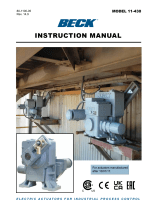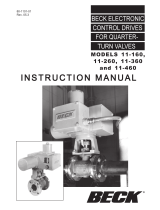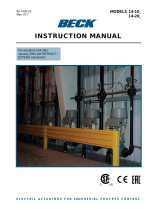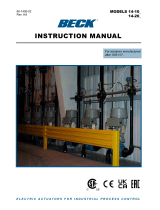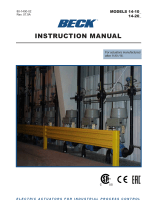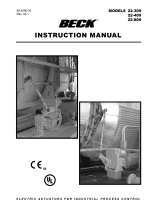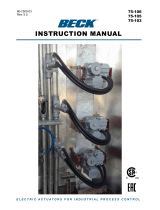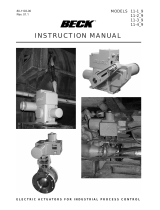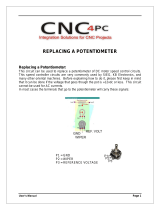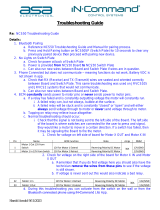Page is loading ...

1
80-1100-05
Rev. 07a
BECK ELECTRONIC
CONTROL DRIVES
MODEL 11-430
INSTRUCTION MANUAL

2
INTRODUCTION TO THE MANUAL
This manual contains the information needed
to install, operate, and maintain the Beck 11-430
Electronic Control Drive, manufactured by Harold
Beck & Sons, Inc.
The 11-430 is a high torque electronic control
drive designed to provide precise position control
NOTICE: This manual includes information that will
make installation simple, efficient, and trouble-free.
Please read and understand the appropriate sections
in this manual before attempting to install or operate
the Model 11-430 drive.
Group 11 quarter-turn
drives ...
are designed specifically
for use with ball, plug, and
butterfly valves. Direct-
coupled, factory-mounted
assemblies are available
from Beck for easy instal-
lation.
Group 14 linear drives ...
are ideally suited for globe
valves from 1 to 8 diam-
eter. Becks unique
Tight-Seater coupling
provides positive seating
of valves.
Group 31 rotary drives ...
are particularly suited for
coupling to ball, plug, and
butterfly valves up to 4 di-
ameter, and small damp-
ers.
of multiple burner tilt arrays, dampers, and other
devices requiring up to 5,200 lb-ft of drive torque.
The 11-430 consists of a Beck 11-400 Electronic
Control Drive connected to a large gear reduction
unit that increases the output torque of the 11-400
by a factor of 3:1.
Beck drives fulfill an industry need for a reliable elec-
tronic control drive. Exceptionally stable and trouble-free,
these drives are in use on valve and damper applications
throughout the world.

3
CONTENTS
Product Description .......................................................................................................................... 4
General Specifications ................................................................................................................... 6
Installation ....................................................................................................................................... 11
Input Signal Wiring ....................................................................................................................... 13
Feedback Signal Wiring ............................................................................................................... 16
Wiring Options ............................................................................................................................. 18
Start-up ........................................................................................................................................ 20
Operation ......................................................................................................................................... 22
Calibration
Switches ...................................................................................................................................... 26
Direction Change ......................................................................................................................... 28
Feedback Signal .......................................................................................................................... 30
Input Signal .................................................................................................................................. 34
Maintenance
Routine......................................................................................................................................... 38
Component Replacement............................................................................................................. 39
Troubleshooting ........................................................................................................................... 43
Appendix
Spare Parts .................................................................................................................................. 47
Control Assembly ......................................................................................................................... 48
CPS-2 Data .................................................................................................................................. 49
CPS-2 Functional Block Diagram ................................................................................................. 51
Control Drive Electrical Schematic ............................................................................................... 52
Index ................................................................................................................................................. 54
Services ............................................................................................................................................ 55

4
PRODUCT DESCRIPTION
The Beck 11-430 control drive is engineered
for precise, reliable operation of dampers and
multiple burner tilt arrays. The cool, stable opera-
tion of Becks control motors coupled with the
powerful gear train provide the tight, responsive
control required by modern control loops to opti-
mize output while keeping operating costs low.
The unique all spur gear construction used in
the Beck Control Drive is designed for long term
durability. The gear train can withstand acciden-
tal stalls of up to four days without failure, and will
resume instant response immediately upon re-
moval of the condition (see page 24 for Stall
Protection information). Mechanical stops in the
gear train prevent over-travel.
An easy-to-turn, spoke-free Handwheel is in-
corporated into the 11-430 design to allow
manual operation during installation or power out-
ages. The Handwheel can be used to move a
driven shaft to any position smoothly and easily
under full load conditions.
The driven shaft may also be operated at its
individual location by utilizing the drives built-in
electric Handswitch.
The heavy-duty crank arm of the 11-430 con-
trol drive can be field-adjusted to travel anywhere
in the 360° range.
Becks ESR-4 Electronic Signal Receiver pro-
vides precise drive control from either
conventional analog or computer based control
systems.
Becks CPS-2 Contactless Position Sensor
provides accurate position feedback in demand-
ing environmental conditions, with no contacting
or wiping surfaces to wear or intermittently lose
contact. The CPS-2 provides infinite resolution
with linearity error of less than ±1% of span over
the drives full travel.
The Beck 11-430 electronic control drive is
designed with individual weatherproof enclosures
to protect the main components. The cutaway il-
lustration below is intended to provide the user
with a basic introduction of the features of the
11-400.
POSITION SENSING AND
FEEDBACK DEVICE
TRAVEL LIMIT
AND AUXILIARY
SWITCHES
ELECTRONIC SIGNAL
RECEIVER BOARD
WIRING TERMINAL BLOCK
GEAR TRAIN AND
MOTOR HOUSINGS
MODEL 11-400 WITH
ADAPTOR PLATE FOR
GEAR REDUCTION UNIT

5
BECK LINKAGE KITS
Beck pipe linkage kits are available for com-
pleting the mechanical connection from the drive
crank arm to the load. Through the use of stan-
dardized selection, the linkage can be ordered
even if the exact length is not determined until the
drive and driven device are installed.
All Beck 11-430 drives are furnished with a
crank arm and rod end (see pages 8, 9, and 21
for dimensions). All rod ends furnished by Beck
incorporate bearings to accommodate some lat-
eral misalignment. Once the connection is made,
linkage kits can be adjusted ±1 1/2 without re-
moval of the crank arm or load lever, making final
mechanical calibration simple.
See page 20 for linkage requirements.

6
PRODUCT DESCRIPTION
Input Power 120 V ac, 3.10 A, single-phase 50 or 60 Hz
240 V ac, 1.55 A, single-phase 50 or 60 Hz
Operating Conditions -40 to 185°F. (-40 to 85°C.)
0 to 99% relative humidity
Input Signal Options, with 05 mA
Electronic Signal Receiver 15 mA
(ESR-4) 420 mA
1050 mA
15 V dc
-1010 V dc
Input Signal Span Adj. 50% to 400% of 4 V span (except -1010 V dc)
Input Signal Zero Adj. -100 to 275% of span (except -1010 V dc)
Deadband 0.6% of span
Sensitivity 25% of deadband
Direct AC 120 V ac for 2-position, multi-position or modulating V ac control
Square Function Drive output shaft moves proportionally to the square of the input signal
(Optional)
Feedback Signal Options, 15 mA
with Contactless Position 420 mA
Sensor (CPS-2) 1050 mA
15 V dc
016 V dc
-1010 V dc
Output Stability 0.25% of span from 102 to 132 V ac
±0.03%/°C. of span for 0 to 50°C.
±0.05%/°C. of span for -40 to 85°C.
Linearity ±1% of span, max. independent error
Hysteresis 0.25% of span at any point
Isolation Max. leakage of 10 µA at 60 V rms, 60 Hz from output to ground
Film Potentiometer 1,000 ohm
Max. Voltage 40 V
Wattage 2 W max.
Linearity ±0.5%
Max. Wiper Current 1 mA
Action on Loss of Power Stays in place
11-430 GENERAL SPECIFICATIONS

7
Action on Loss of Input Stays in place or moves to full travel or zero position. Drives to any preset
Signal (Power On) position with optional switch assembly on Models 11-437 and 11-438.
Field adjustable.
Stall Protection and If the motor tries to run in one direction for more than 300 seconds, the
Annunciation (Optional) Stall Protection Module will shut off power to the motor and a relay contact
will change state. The relay is rated for 120 V ac or dc, 10 VA. For more
information, see Beck publication 80-0017-03.
Limit Switches Two SPDT, one for CW and one for CCW extended limit of travel. Stan-
dard switch setting is for 100° of travel.
Auxiliary Switches Up to four 6 A, 120 V ac switches available.
Switches are labeled S1 to S4 and are cam-operated, field-adjustable.
S1 and S4 are set to operate just before reaching CCW travel limit.
S2 and S3 are set to operate just before reaching CW travel limit.
Handswitch Permits local electrical operation, independent of controller signal. Stan-
dard on all units. An optional auxiliary contact can be used to indicate that
the Handswitch is in AUTO mode or to sound an alarm if it is taken out of
AUTO.
Handwheel Provides manual operation without electrical power.
Motor 120 V ac, single-phase, no-burnout, non-coasting motor has instant
magnetic braking. Requires no contacts or moving parts. Can remain
stalled for four days without failure of motor or gearing.
Gear Train High-efficiency, precision-cut, heat-treated alloy steel and ductile iron spur
gears. Interchangeable gear modules permit field change of timing.
Mechanical Stops Prevent over-travel during automatic or manual operation.
Enclosures
11-400 Drive Precision-machined aluminum alloy castings, protected with corrosion-
resistant polyurethane paint, provide a rugged, dust-tight, weatherproof
enclosure.
Gear Reduction Unit Precision-machined aluminum plates, protected with corrosion-resistant
polyurethane paint, provide a rugged, dust-tight, weatherproof enclosure.
Crank Arm Manufactured to the radius required by the application.

8
PRODUCT DESCRIPTION
All Dimensions are in inches.
*Crank arm is manufactured to the radius required by the application.
BECK MODEL 11-430
ORIENTATION A
Front View Side View

9
MODEL 11-430 RECOMMENDED BOLT TORQUES
ORIENTATION B
Front View Side View

10
PRODUCT DESCRIPTION
TABLE 1:
SUMMARY OF CONTROL OPTIONS
*13-2245-09 Square Function Board is available in these ranges.

11
INSTALLATION
SAFETY PRECAUTIONS
WARNING
Installation and service instructions are for
use by qualified personnel only. To avoid in-
jury and electric shock, do not perform any
servicing other than that contained in this
manual.
STORAGE INFORMATION
The 11-430 should be stored in its shipping
crate in a clean, dry area.
If it is necessary to store the drive outdoors for
a long period of time, it should be stored above
ground and covered with a waterproof cover. Do
not stack 11-430 crates on top of one another.
Stored drives should be checked periodically to
make sure no condensation has formed in the
electronic and terminal compartments. Damage
due to moisture while in storage is not covered by
warranty.
UNPACKING
The drive is shipped in a slatted wooden
crate. The crate is braced internally at the top
and sides of the drive. To unpack, remove the
top of the crate first. Then remove the sides of
the slatted crate, carefully removing the support
braces. After unpacking, the skid may be used to
transport the drive to the installation site.
Orientation Option A (Page 8)
The 11-430, orientation option A, is bolted to a
removable wooden pedestal with four 3/4 hex
head bolts. These bolts are not to be used for
mounting the drive to its final mounting platform.
The pedestal provides a mounting base for the
drive and also protects the 11-400 control motor.
Do not remove the drive from the pedestal or the
protective cover from the motor until the drive is
ready to be placed on its final mounting platform.
The pedestal is attached to the wooden shipping
skid with metal banding.
Orientation Option B (Page 9)
The 11-430, orientation option B, is bolted di-
rectly to the wooden shipping skid. These bolts
are not to be used for mounting the drive to its fi-
nal mounting platform. Do not remove the drive
from the skid or the protective cover from the mo-
tor until the drive is ready to be placed on its final
mounting platform.
MOUNTING INSTRUCTIONS
The Beck 11-430 can be installed in any con-
venient orientation because the gear train does
not require an oil bath. Refer to the outline di-
mension drawing for physical dimensions and
required clearances.
Continued
MODEL 11-430 CONTROL DRIVE
Figure 1

12
INSTALLATION
The 11-430 must be bolted firmly to a mount-
ing surface which will not yield to the stresses
created from operating the device. Use 1 diam-
eter grade 5 bolts and torque to 480 Ib-ft. A flat,
rigid, vibration-free surface will generally prolong
the life of the drives components. Place shims
under the feet of the drive to correct for any un-
evenness in the mounting surface before the
mounting bolts are tightened.
The output shaft of the drive should be parallel
to the driven shaft, and the linkage should be per-
pendicular to the plane of the two shafts. Small
misalignments can be tolerated if a rod end fitting
is used on the driven lever similar to that provided
on the Beck crank arm.
ORIENTATION OPTIONS
The 11-400 can be assembled to the 11-430
gear reduction unit in two different positions.
These are shown as Orientation Options A and B
in the outline dimension drawings on pages 8 and
9. The choice of orientation option depends on
the installation and the need to access the wiring
and electrical adjustments of the 11-400 drive.
Normally the orientation option is selected at the
time of order and factory-assembled to that speci-
fication. The orientation option can be changed.
Caution: Consult the factory before attempting to
change the drive orientation.
INSTALLATIONELECTRICAL
NOTE: All Beck drives are shipped from the
factory ready for installation; no electrical ad-
justments are required before placing them in
operation. Each drive is set up and calibrated
to the customers specifications that were
written into the equipment order.
Two N.P.T. conduit connections are provided.
The 1/2 conduit is for signal wiring connections,
and the 1 conduit is for power and auxiliary
switch connections.
A sealant must be used on the threaded con-
duit connections to keep moisture out. The
conduits should be routed from below the drive so
that condensation and other contaminants enter-
ing the conduits cannot enter the drive.
MOUNTING INSTRUCTIONS, CONTD.A large, clearly labeled terminal block on the
top of the drive is enclosed in a separate,
gasketed, metal enclosure. Terminals will ac-
commodate up to 12 GA wiring (see page 4 for
location of the terminal block).
CAUTION
Always close covers immediately after instal-
lation or service to prevent moisture or other
foreign matter from entering the drive.
Refer to the wiring diagram furnished with
your Beck drive for proper AC power and signal
connections. It is advisable to provide normal
short circuit protection on the AC power line. A
copy of the wiring diagram is shipped with each
drive and is fastened to the inside of the terminal
block cover. If there is no wiring diagram avail-
able, you may obtain a copy from Beck by
providing the serial number of your drive.
Your Beck drive has been supplied to match
the signal source in your control loop. If it does
not match, refer to the Input Signal Options sec-
tion of this manual, page 18, for information on
how to change the input signal range.
For maximum safety, the Beck drive body
should be grounded. Use the grounding terminal
provided in the drive body.

13
INSTALLATION INPUT SIGNAL WIRING
Each Beck drive is available with six separate
control configurations, which are provided to
match the control requirements for your system.
Typical functional wiring connections for each
control option are described in the following para-
graphs and diagrams. See the wiring diagram on
the inside of the terminal cover for specific wiring
connections. See Table 1 on page 10 for model
numbers and control selections.
Feedback connections for drives incorpor-
ating the Contactless Position Sensor (CPS-2) for
control options 6 and 8 are described on pages
16 and 17.
A drive can be ordered with up to four optional
auxiliary switches. Wiring connections for these
are described on page 26.
To disable the Handswitch, remove the
jumper between terminals A and C, and add
jumpers between terminals N and V, M and U.
Option 8, Modulating
Analog Position Control with
Contactless Position Sensing
Customer must supply two wires to power the
drive: One 120 V ac line (terminal C), and one
neutral (terminal B). Customer must supply two
wires for the modulating analog control signal:
Connect to terminal AA (+) and to terminal BB(-).
Customer may supply two additional wires to
monitor the analog position feedback signal (see
pages 16 and 17 for connections). The drives
feedback circuit power supply is derived from the
120 V ac line, therefore the feedback signal must
be wired to a 4-wire type non-powered analog
input.
Option 7, Modulating
Analog Position Control with
Potentiometer Position Sensing
Customer must supply two wires to power the
drive: One 120 V ac line (terminal C), and one
neutral (terminal B). Customer must supply two
wires for the modulating analog control signal:
Connect to terminal AA (+) and to terminal BB (-).
If position feedback monitoring is required, an op-
tional auxiliary potentiometer can be ordered.
The optional auxiliary potentiometer connects to
terminals CC (Reverse), DD (Wiper), and EE
(Forward) and is compatible with standard
slidewire style inputs.
NOTE: Stall Protection Module shown is avail-
able as an option.

14
INSTALLATION INPUT SIGNAL WIRING
Option 6, Modulating
Direct AC Control with Contactless
Position Sensing
Customer must supply three wires to directly
control the drive motor direction: One 120 V ac
line to run Forward (terminal M), one 120 V ac line
to run Reverse (terminal N), and one neutral (ter-
minal B). Customer may supply two additional
wires to monitor the analog position feedback sig-
nal (see pages 16 and 17 for connections). If
position feedback monitoring is desired, a 120 V
ac line must be connected to terminal C. The
drives feedback circuit power supply is derived
from this 120 V ac line, therefore the feedback
signal must be wired to a 4-wire type,
non-powered analog input.
Option 5, Modulating
Direct AC Control with Potentiometer
Position Sensing
Customer must supply three wires to directly
control the drive motor direction: One 120 V ac
line to run Forward (terminal M), one 120 V ac line
to run Reverse (terminal N), and one neutral (ter-
minal B). The position feedback potentiometer
connections are available at terminals CC (Re-
verse), DD (Wiper), and EE (Forward).
Option 4, Multi-Position
Direct AC Control with Cam-Operated
Switches to Stop Drive Travel
Customer must supply three wires to directly
control the drive motor direction: One 120 V ac
line to run Forward (terminal M), one 120 V ac line
to run Reverse (terminal N), and one neutral (ter-
minal B). Up to six intermediate stop positions
may be specified, each requiring an additional
120 V ac line.

15
Option 3, Open / Close
Direct AC Control
Customer must supply three wires to directly
control the drive motor direction: One 120 V ac
line to run Forward (terminal M), one 120 V ac line
to run Reverse (terminal N), and one neutral (ter-
minal B).
240 V ac Operation
All of the options described above are avail-
able for 240 V ac operation instead of 120 V ac
operation. In all cases, the power neutral is re-
placed with Line 2 of the 240 V ac, and the 120 V
ac line is replaced with Line 1 of the 240 V ac.

16
INSTALLATION FEEDBACK SIGNAL WIRING
CPS-2 SIGNAL CONNECTIONS
Beck 11-430 drives equipped with the
Contactless Position Sensor (CPS-2) are shipped
ready for installation. They are engineered to
match the mA or V dc feedback range in your
system.
Customer connections for feedback signal
wiring on each CPS-2 model are described in the
following diagrams and paragraphs. Refer to
Table 12, page 50 for a table of output signal
ranges, output terminals, range changing resis-
tance values, and terminals to which the ranging
resistor or jumper is connected.
NOTE: The value of R8 Feedback Gain Re-
sistor affects output shaft rotation range; where:
R8 = 100 K ohms produces a shaft output range
of 80100°; R8 = 249 K ohms produces a shaft
output range of 7080°; and R8 removed pro-
duces a shaft output range of 6070° (see Figure
5, page 32 for location of R8).
To verify that the feedback signal range is cor-
rect for your drive, see instructions on page 31.
NOTE: Ranging resistors must be connected
to the control drive output terminals. If a
ranging resistor change is required, it may be
obtained locally. If resistors with ±1% toler-
ance are not available, they can be ordered
from Beck.
CPS-2 Model 20-3400-02, -12
Terminal Connections
1. A single 420 mA current output is available
between terminals EE (+) and CC (-) when
driving into an external load between 250 and
800 ohms. No ranging resistor is required.
2. For 420 mA and / or 15 V dc output, 420
mA is available across EE (+) and DD (-); 500
ohms is the maximum external load (for larger
loads see Item 1 above). A 15 V dc signal is
available across DD (+) and CC (-) into a 12 K
ohm resistive load when the circuit between
EE and DD is completed.
420 mA Signal Output
Dual Signal Output
CPS-2 Model 20-3400-03, -13
Current Feedback
Terminal Connections
The universal model has current sensing ter-
minals, which allow for various current signal
ranges. Current output is available between ter-
minals DD (+) and CC (-) with the proper ranging
resistor connected across terminals DD and EE.
Units are factory-calibrated for specified sig-
nal ranges and are provided with proper resistors
installed.
The ranging resistor value is given in Table
12, page 50, or can be calculated using the fol-
lowing equation:
Where R = Resistor (Ohms) Connected from
DD to EE
I = Output Current Span (Amp)
If converting to a zero-based range (a range
that includes zero as an end point), refer to Ad-
justing the Zero Potentiometer section, page 33.
Current Output

17
CPS-2 Model 20-3400-03, -13
Voltage Feedback
Terminal Connections
The universal model has a voltage divider net-
work, which allows for various voltage signal
ranges. Voltage output ranges are available
across terminals EE (+) and CC (-) with the
proper ranging resistor connected across termi-
nals CC and DD.
Units are factory-calibrated for specified sig-
nal ranges and are provided with proper ranging
resistors installed. Other voltage ranges are at-
tainable by adding a ranging resistor across
terminals CC and DD.
The ranging resistor value is given in Table
12, page 50, or can be calculated using the equa-
tion:
Where R = Resistor Connected from CC to
DD
V = Output Voltage Span
If converting to a zero-based range (a range
that includes zero as an end point), refer to Ad-
justing the Zero Potentiometer Section, page 33.
Voltage Output
CPS-2 Model 20-3400-04, -14
Terminal Connections
The three-terminal output from these models
is provided for replacing potentiometers in three-
terminal potentiometer feedback applications
used in many controllers. It is suitable for 015 V
dc applications of either positive or negative po-
larity. CC must be connected to the negative lead
from the controller, and EE to the positive lead
from the controller, with DD connected to the con-
troller lead accepting the feedback from the
potentiometer wiper. These models can source
10 mA to the controller, or they can sink 2.5 mA
from the controller.
Potentiometer Equivalent
CPS-2 Model 20-3400-05, -15
Terminal Connections
Voltage signal -10 to +10 V dc is available
across terminals EE (+) and DD (-). The maxi-
mum load is 5 mA.

18
INSTALLATION WIRING OPTIONS
INPUT SIGNAL OPTIONS
Beck 11-430 drives configured for milliamp or
dc analog modulating applications include an
Electronic Signal Receiver (ESR-4). Several con-
trol options are available with the ESR-4, such as
operating more than one drive with a single signal
source.
The instructions below apply to applications
that require a signal change or to situations call-
ing for operation of multiple drives from a
common input signal.
Input Signal Range Change
If it is necessary to change the range of an
ESR-4 board to receive a different input signal
current, the R-in resistor must be changed. See
Table 2 below for the proper value, and Figure 7
on page 35 for its location on the board. It is
mounted on turrets to facilitate the change. After
soldering the new resistor in place, recalibrate in
accordance with the instructions on page 34. If a
proper resistor with ±1% tolerance cannot be ob-
tained locally, it can be ordered from Beck.
Series Operation
Beck drives can be connected in series from
the same signal for concurrent operation. Care
must be taken to keep the polarity correct in each
drives input terminals. Two or three drives may
usually be connected in series. The number of
drives that may be connected in series is limited
only by the controllers (signal source) capability
to feed current into the total resistance of the
circuit involved. Consult the controller
manufacturers recommendations.
No change is required to the drives cali-
bration for series operation. An interruption in the
circuit will actuate loss of input signal (L.O.S.) on
the drives in the circuit.
Parallel Operation
Beck drives can be connected in parallel to
the same signal for concurrent operation. Up to
four drives may be connected in parallel.
For parallel operation, use ESR-4 board no.
13-2245-05 in each drive, and add a shunting re-
sistor across input terminals AA and BB on one of
the Beck drives. The value of the resistor is:
Where N = the number of drives.
Refer to Table 2 for the input resistance. For ex-
ample, a 278 ohm shunting resistor should be
used for four drives in parallel with a 420 mA in-
put signal. If the resistance calculation is not a
standard value, then select the nearest standard
value.
A minor span adjustment is required for each
drive in a parallel circuit. An interruption in the cir-
cuit to one drive will not prevent the other drives
from functioning, but there will be a slight calibra-
tion shift.
TABLE 2:
ESR-4 BOARD MODELS
*Span and zero adjustment required.
**Standard ISA Range (S 50. 1/1975).

19
Split Range Operation
Two or three Beck drives may be operated
over their full range by a portion of the controllers
output signal range. The most common arrange-
ment involves two drives operating on equal
halves of the input signal range. For example, if a
420 mA control signal is used, the first drive
would move 100% of its stroke on a signal range
of 412 mA, while the second operates on the
1220 mA portion of the signal. In this case, the
ESR-4 boards are the same as would be used for
parallel operation (13-2245-05), but calibrated to
the range required for each drive. A shunting re-
sistor must be added across input terminals AA
and BB on one of the Beck drives to produce a
2.06.0 volt span across each board for its active
portion of the range. For a 420 mA range three-
way split, the shunting resistor range would be
4251,650 ohms.
Follow the steps for calibrating the input sig-
nal, page 34, for each drive unit, using half span
values for the input signal. Use the proper start-
ing point for each half-range when setting the
zero, 4 mA and 12 mA. Before setting the zero on
the second drive (12 mA), cut one lead of resistor
R35 on the ESR-4 board. See figure 7, page 35,
for location of R35.
In a split range configuration, connect ter-
minals E and F (L.O.S. wire) to prevent undesired
stay-in-place operation of the second or third
drive due to fast, downward signal changes.
When three drives are to be operated on
equal portions of the input signal, the 420 mA
range would split into 49.33 mA, 9.3314.67 mA,
and 14.6720 mA signals. A 487 ohm shunting
resistor (Beck P/N 13-2510-03) is adequate. Pro-
ceed as in the case of the two-way split, first
setting span, then the zero. When setting the
ESR-4 board in the first drive, set the zero at
4 mA. Then, on the second drive, cut the R35
resistor on the board and set its zero at 9.33 mA.
Before setting zero in the board of the third drive,
short out the R34 resistor by adding a jumper, ad-
just its zero to 14.67 mA, cut resistors R35 and
R36 from the board, then remove the jumper from
R34. Check operation of all drives by running the
input signal through its complete range. If it is
necessary to recalibrate the same board later,
you may jumper resistors R35 and R36 by con-
necting the R35 turrets together.

20
INSTALLATION START-UP
START-UP INSTRUCTIONS
After the drive is mounted and its wiring con-
nections are made, it is ready to be tested for
proper operation.
NOTE: All Beck drives are shipped from the
factory ready for installation; no electrical ad-
justments are required before placing them in
operation. Each drive is set up and calibrated
to the customers specifications that were
written into the equipment order.
Turn on the power supply. Operate the drive
with the Handswitch and run it through its full
stroke in both directions. Observe that the driven
device travels through its desired stroke. If satis-
factory, set Handswitch to the AUTO position.
If the drive is to be operated with automatic
control, turn on the controller and operate the
drive by varying the control signal. Check that the
driven shaft strokes in the proper direction for a
change in control signal. If it does not, first check
for proper wiring connections and verify control
signal at the drive. If the wiring is correct, then
reverse the direction of travel (see page 28).
If the drive is to be push-button actuated, (op-
tions 3, 4, 5, or 6) operate the drive using the
Handswitch and observe that direction of travel is
correct. When travel of the driven device is satis-
factory with reference to the control signal or the
push-buttons, the unit is ready for operation.
LINKAGE REQUIREMENTS
In most applications, the best control will re-
sult when the linkage is adjusted so that the full
100° angular travel of the Beck drive shaft is
used, even though the driven shaft may travel
less than 100°.
The general requirements for a good linkage
are:
1. It must be rigid enough to carry the link thrust
without bending or deforming.
2. It must have a built-in means of adjustment so
that the length of the connecting link can be
changed a small amount.
3. Rod end bearings, similar to those furnished
on the Beck crank arm, should be used at
both ends of the connecting link. This type of
device permits small angular misalignments,
and helps prevent binding of the linkage.
4. The radius of the Beck crank arm must be cal-
culated so that it will move the valve or
damper lever through the correct arc as it
travels from 0° to 100°.
5. The drive and driven shafts must be parallel
and the linkage should be in a plane perpen-
dicular to the shafts.
The following procedure is recommended to
couple the linkage between the Beck drive and
the driven shaft:
1. Position the driven shaft to the full reverse po-
sition.
2. Set the driven shaft lever to its predetermined
starting angle in relation to the driven shaft
and drive shaft centerline.
3. Remove the rod end from the Beck crank arm.
Thread the rod end fully onto the pipe cou-
pling stud.
4. Adjust the pipe coupling to the predetermined
length.
5. Connect the pipe coupling to the driven lever
at the predetermined radius.
6. Loosen the Beck crank arm clamping bolts.
7. Position the drives output shaft to its full re-
verse (minimum input signal) limit.
8. Swing the crank arm into position to assemble
the rod end to the crank arm crank pin with the
rod end bolt and washers.
9. Tighten the rod end bolt to the torque recom-
mended on page 9.
10. Tighten the coupling and rod end jam nuts.
11. Tighten the crank arm clamping bolts (4) to
the torque recommended on page 9.
12. Lubricate rod end bearings with LGI #1 EP
grease, Mobil grease #28 or equivalent.
Carefully move the drives output shaft to the
full forward (maximum input signal) position.
Check that no binding occurs between the link-
age, crank arm, driven shaft lever, and
surrounding obstructions. Also observe that the
driven shaft rotates the proper amount. Check
that the drive reaches the forward limit switch and
shuts off.
If binding in the linkage occurs due to too
much travel of the driven lever, reduce the crank
arm radius, if possible, or adjust the connecting
link length.
To adjust linkage length, alter the thread en-
gagement in the couplings and, if necessary, the
rod ends. The couplings have right- and left-hand
threads, so it is not necessary to disconnect the
ends to make a length adjustment. Rod end ad-
justment, however, will require disconnecting the
linkage.
CAUTION
The stud threads must be engaged at least 1.0
diameter deep into the rod ends and pipe cou-
plings.
/
